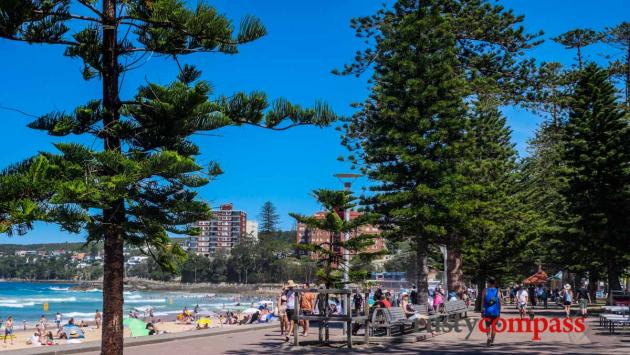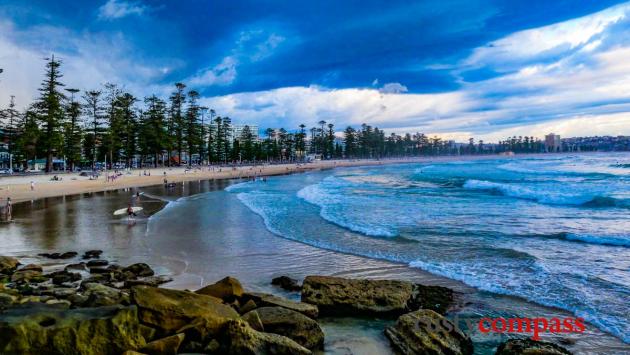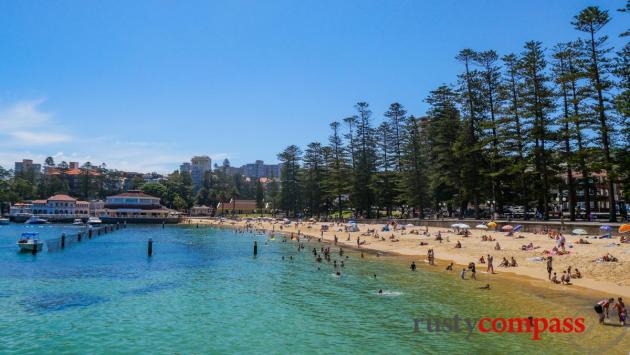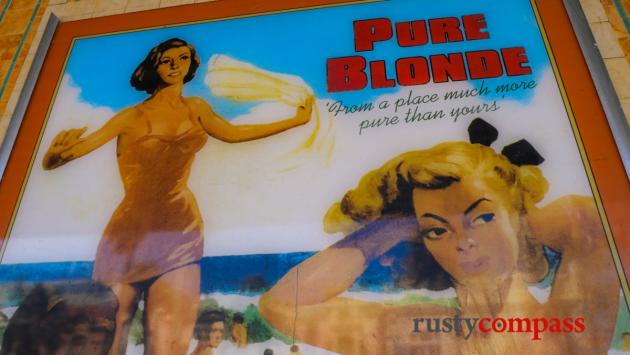Sydney's Northern Beaches district is a vast sweep of stunning coastline that stretches almost 30kms north to Palm Beach, passing dozens of idyllic beaches along the way. The most southerly and the most famous of these beaches, is Manly. The whole Manly experience, from the spectacular ferry ride from Circular Quay, to the rich offerings of ocean and harbour swimming, to glorious coastal walks, make this an amazing year-round destination.

Photo: Mark Bowyer The Manly Ferry at Manly Wharf
Manly or Bondi?
If you're a visitor to Sydney and only have time for one beach, make it Manly. The reason I say that is less about the beach and more about the overall Manly experience. The Manly ferry from Circular Quay is an essential, inexpensive Sydney experience with breathtaking views of the Opera House, the Harbour Bridge and Sydney Heads. Manly offers the best range of swimming, walking, dining and pubs of any of Sydney's main beaches.

Photo: Mark Bowyer Manly Beach mid-summer.
Manly Beach Travel information
From the Ferry Wharf, Manly Beach is a short walk along the historic Corso. Check out the architecture, there are some fabulous early twentieth century buildings along here.
The distinctive Norfolk Island pine trees, that line Manly Beach promenade, were first planted in the mid nineteenth century and create Manly's resort-escape feel.
Patrolled swimming at Manly Beach is focused to the south of a long stretch of sand that runs 2 kms north to Queenscliff. It's usually a right turn at the end of the Corso.
Not far around from Manly's main ocean beach, there's a little patch of protected paradise at Shelly Beach, a 15 minute walk south. Back towards the harbour there are perfect protected swimming spots for families and anyone less confident about braving the sometimes hazardous ocean.
Open water swimmers (strong experienced swimmers) often swim to 750m from Manly Beach to Shelly Beach (the return is 1.5kms). This is the route of the famous annual Cole Classic ocean swim.
Manly is a great starting point for some incredible Sydney walks. The short walk to Shelly Beach is a delight. Longer walks include the old Quarantine Station and dramatic coastal scenes at North Head and the harbour views of the Manly to Spit walk.

Photo: Mark Bowyer Norfolk Island Pines line Manly Beach, Sydney
Protected beaches near Manly
Visitors to Manly are spoilt for choice when it comes to divine beaches. If the waves of Manly's main ocean beach put you off, take the scenic walk around to the protected picturesque Shelly Beach. It's a good spot for families and there's great snorkelling. The Fairy Bower pool along the walk to Shelly Beach is a sweet spot to stop for a dip.
Manly's harbour beaches also offer safer, protected swimming. The beach at Manly Cove, right by the ferry wharf is netted and popular with families. Little Manly Beach is a nice walk from the ferry and is usually less crowded.
If you want to avoid the crowds, try visiting Manly on weekdays rather than weekends - especially in summer. Things usually quieten down in the late afternoon - even in summer.

Photo: Mark Bowyer Paradise in the city - Shelly Beach Manly - minus the crowds
Getting to Manly Beach
The Manly Ferry is by far the best way to get to Manly from the centre of Sydney. Take the slow ferry (40 mins) and grab a seat on the deck for fantastic views of Sydney's harbour. The Manly Ferry is one of the best value for money experiences in Sydney.
The Manly Ferry Wharf is around 10 minutes walk from Manly Beach along The Corso shopping strip. Manly Cove harbour beach is right by the wharf.
It's also possible to get to Manly by bus and car - parking will be tight on weekends in summer.

Photo: Mark Bowyer Walking path, Manly to Shelly Beach
Manly History
Manly sits on the traditional lands of the Cammeraygal people who prospered along the harbour foreshore for many millennia prior to the British Invasion in 1788. The area we know as Manly Cove was one of the first places visited by Governor Arthur Phillip and his men when they made their first survey of Sydney Harbour by rowboats from from Botany Bay, prior to making settlement at Sydney Cove in January 1788.
Arthur Phillip named Manly in recognition of the masculine qualities he noted among the Indigenous men of the area.
Manly features on a number of significant occasions in the early interactions of Arthur Phillip's First Fleeters and local Indigenous people.
Manly was the site of two of the first abductions of Indigenous men by the British invaders, for the purpose of learning local language and customs. The first involved Arabanoo, who was seized from Manly at the end of 1788. He died in captivity in the catastrophic smallpox outbreak in 1789 that decimated the local Indigenous population. Arabanoo may have been Australia's first Aboriginal death in custody - though restrictions on him were minimal prior to his death. His final days were spent painfully surveying the catastrophe that had befallen his people from smallpox.
Later in 1789, Governor Phillip sent his forces to Manly again to abduct two more Indigenous men for the purpose of forced exchange of linguistic and cultural skills. This time his captives were Bennelong and Colebee - neither men were natives of Manly. They both went on to achieve fame in the British colony.
The Manly abductions mark the beginning of the forced removal of Indigenous Australians from their families and traditional lives by the colonial invaders. It's a dark chapter in Australian colonial history that has continued to recent decades. It should be marked at Manly.
Bennelong became the first Indigenous man to develop fluency in English and British cultural life. He then became the first Indigenous man to travel to England, when he accompanied Arthur Phillip at the end of his posting in 1792. On his return to Australia, he distanced himself from the colonial world. He died estranged from the culture that he had been forcibly inducted into - choosing a life among his people over a life of privilege among the colonists.

Photo: Mark Bowyer The First People don't rate a mention in 1928 - things haven't improved much
Manly Cove was also the location of one of the first acts of resistance against British invaders when Governor Arthur Phillip was injured by a spear thrown by local man Willemering. Phillip controlled his men on this occasion and further bloodshed was avoided. Neither Phillip nor his successors would show similar restraint when Indigenous people asserted their sovereignty over their lands in future confrontations. The Manly Cove attack is one of the most significant in early penal colony history but is unknown by most Australians.

Photo: Mark Bowyer Manly Cove - site of many historical encounters
By the mid nineteenth century, Indigenous numbers around Manly had fallen away and colonial settlers began to occupy the land. Some saw Manly's potential as a seaside escape from the city - in a similar mould to British seaside towns like Brighton.
The first Norfolk Island pines were planted in the 1850s and they continue to be a distinctive feature of the beachfront.
In the early 1900s, Manly was the first beach to permit daytime bathing in neck to knee swimming costumes. Ocean bathing had an inauspicious start with 17 drownings in 1903.
In 1904 Manly's celebrated surf club opened. Like others around Sydney, it claims to be the first - though its claims seem to be the most credible.
The lure of the beach soon saw the development of a surfing culture at Manly that flourishes to this day. Manly has been the centre of Sydney's surfing culture and many world surfing firsts for more than a century.
SPECIAL NOTE - WRITING ABOUT MANLY HISTORY
Often when I write a brief history of a place, I find myself sifting through vast amounts of historical information online of varying quality. Wikipedia and local and state government resources usually cover the essentials. When writing this piece I was surprised at how little effort has been made to tell a coherent, digestible Manly story online - anywhere. The omission of information of Indigenous history is astonishing. Even the surfing history is not well covered. I hope this is a modest advance but it definitely will evolve as research continues.










There are no comments yet.